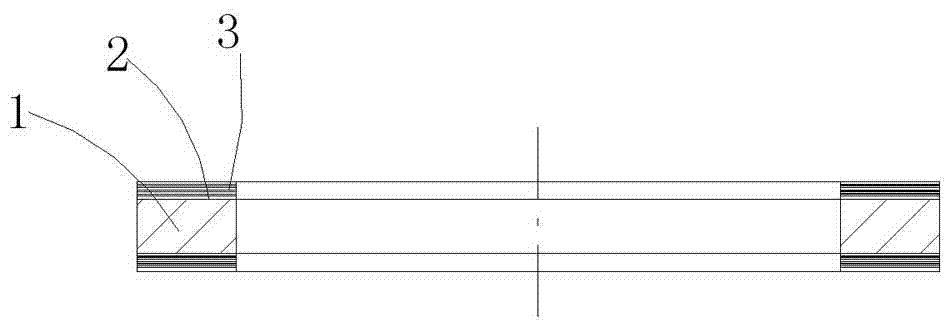Copper-based powder metallurgy thrust ring and preparation method thereof
A powder metallurgy and thrust ring technology is applied in the field of copper-based powder metallurgy thrust rings and their preparation, and can solve the problems of high molding pressure, high manufacturing cost, and complex thrust ring manufacturing methods.
- Summary
- Abstract
- Description
- Claims
- Application Information
AI Technical Summary
Problems solved by technology
Method used
Image
Examples
Embodiment 1
[0033] Such as figure 1 As shown, a copper-based powder metallurgy thrust ring, the copper core plate 1 is sprayed with tin bronze powder Sn6-6-3 as the bonding layer 2, and the bonding layer 2 is composited with copper-based powder metallurgy Friction layer 3; the copper-based powder metallurgy anti-friction layer 3 is formed by fully mixing 8% tin powder, 2% lead powder, 1% graphite powder and the rest copper powder. The thickness of the tin bronze powder bonding layer is 0.07mm. The thickness of the finished copper-based powder metallurgy anti-friction layer 3 is 0.4mm.
[0034] A method for preparing a copper-based powder metallurgy thrust ring, comprising the following steps:
[0035] (1) Copper plating layer: Copper plating is carried out on the surface of the stamped steel core plate after derusting and degreasing, and the thickness of the plating layer is 0.01mm;
[0036] (2), Coating adhesive layer and composite copper-based powder metallurgy anti-friction ...
Embodiment 2
[0045] Example 2: as figure 1 As shown, a copper-based powder metallurgy thrust ring, the copper core plate 1 is sprayed with tin bronze powder Sn6-6-3 as the bonding layer 2, and the bonding layer 2 is composited with copper-based powder metallurgy Friction layer 3; the copper-based powder metallurgy anti-friction layer 3 is formed by fully mixing 9% tin powder, 3% lead powder, 1% graphite powder and the rest copper powder. The thickness of the tin bronze powder bonding layer is 0.08mm. The thickness of the finished copper-based powder metallurgy anti-friction layer 3 is 0.5mm.
[0046] A method for preparing a copper-based powder metallurgy thrust ring, comprising the following steps:
[0047] (1) Copper plating layer: Copper plating is carried out on the surface of the stamped steel core plate after derusting and degreasing, and the thickness of the plating layer is 0.013mm;
[0048] (2), Coating adhesive layer and composite copper-based powder metallurgy anti-frict...
Embodiment 3
[0057] Example 3: as figure 1 As shown, a copper-based powder metallurgy thrust ring, the copper core plate 1 is sprayed with tin bronze powder Sn6-6-3 as the bonding layer 2, and the bonding layer 2 is composited with copper-based powder metallurgy Friction layer 3; the copper-based powder metallurgy anti-friction layer 3 is formed by fully mixing 10% tin powder, 4% lead powder, 1% graphite powder and the rest copper powder. The thickness of the tin bronze powder bonding layer is 0.10 mm. The thickness of the finished copper-based powder metallurgy anti-friction layer 3 is 0.6mm.
[0058] A method for preparing a copper-based powder metallurgy thrust ring, comprising the following steps:
[0059] (1) Copper plating layer: Copper plating is carried out on the surface of the stamped steel core plate after derusting and degreasing, and the thickness of the plating layer is 0.015mm;
[0060] (2), Coating adhesive layer and composite copper-based powder metallurgy anti-f...
PUM
| Property | Measurement | Unit |
|---|---|---|
| thickness | aaaaa | aaaaa |
| thickness | aaaaa | aaaaa |
| thickness | aaaaa | aaaaa |
Abstract
Description
Claims
Application Information
 Login to View More
Login to View More - R&D
- Intellectual Property
- Life Sciences
- Materials
- Tech Scout
- Unparalleled Data Quality
- Higher Quality Content
- 60% Fewer Hallucinations
Browse by: Latest US Patents, China's latest patents, Technical Efficacy Thesaurus, Application Domain, Technology Topic, Popular Technical Reports.
© 2025 PatSnap. All rights reserved.Legal|Privacy policy|Modern Slavery Act Transparency Statement|Sitemap|About US| Contact US: help@patsnap.com

